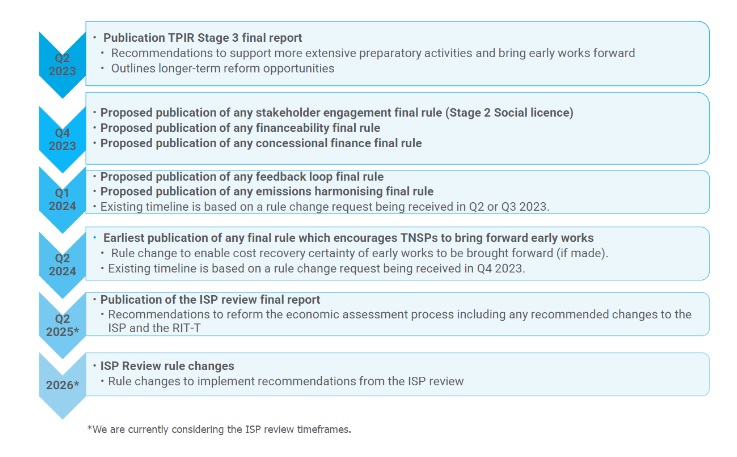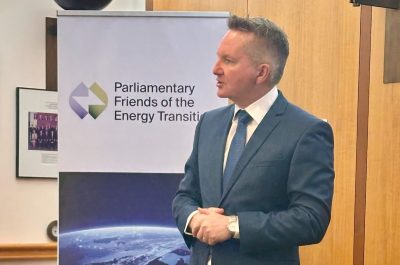Transmission Planning Stage 3 – It’s a wrap
By Verity Watson, Energy Networks Australia
It’s a wrap!
After two years of a multi-staged transmission planning and investment review, the Australian Energy Market Commission (AEMC) has issued its final stage three report.
Some seven or eight rule changes were recommended across the two stages and will be progressed with updates to Australian Energy Regulator (AER) guidelines or new guidance notes to be developed over the next 18 months. The changes are designed to help transmission investor confidence and improve or streamline the regulatory framework and consumer confidence in the Integrated System Plan (ISP).
How we got here
The AEMC has conducted a review of transmission planning and investment frameworks in several stages over the past two years, including:
- Stage two – immediate or incremental reforms concluded with a final report in October 2022 recommending a number of rule changes on financeability, social license and workability of the feedback loop, and
- Stage three – longer term structural reforms, such as reforming the economic assessment process for transmission investment, which concluded with a final report in May 2023 and recommended bringing forward early works in the regulatory investment test. The report also considered the integration of emissions reduction in the regulatory investment test and ISP and concessional financing.
The AEMC also reviewed various contestability models and shelved broader work on contestability, given it would be unlikely to soon gain traction across National Electricity Market (NEM) jurisdictions.
So, what’s the progress of the changes from the stage two and stage three final reports?
The AEMC has received rule change requests on financeability and social licence and is yet to commence consultation. The other rule change remaining for stage two is the improved operability of the feedback loop.
The AEMC had already received the concessional financing rule change request from Minister Bowen ahead of the stage three final report being released.
The stage three final report proposes two rule changes; one to improve the economic assessment process and cost recovery and the other to allow a separate ex-post review for ISP projects.
The report does not recommend a second economic assessment option, where the Australian Energy Market Operator (AEMO) would assess a project’s benefits and decide on the broad option. In this option the regulatory investment test becomes a least-cost test.
This will be considered in the AEMC’s ISP review, which is required under the rules to be completed by mid-2025.
Concessional financing
Minister Bowen has requested a rule change relating to concessional financing which does not include a draft rule, so much of the detail will need to be developed by the AEMC. The Minister has asked for the rule change to be prioritised and ENA understands that this rule change and a financeability rule change could start shortly. The objective is to clarify how the financial benefit from concessional financing of transmission infrastructure can be shared between consumers and transmission businesses.
The proposal can include Rewiring the Nation funding and other government concessional funding.
The rule change request proposes two options for the benefit to flow to consumers – a capital contribution (net present value adjustment) or a revenue adjustment.
On its face it appears that the agreement between the funding body and the transmission business will determine the value to be shared with consumers, the proportion or extent of the value shared, and the mechanism by which it should be shared.
Early works
The AEMC has proposed that an early works contingent project application could be sought before completion of the regulatory investment test for transmission.
To be eligible to submit a contingent project application, the early works must exceed the larger of $30 million or five per cent maximum allowed revenue for the first year of the regulatory period and could allow early procurement of equipment that may be needed regardless of preferred option.
The AEMC proposes that an early works definition in respect of an actionable ISP project could include activities undertaken before construction and which improve cost accuracy and facilitate the project being delivered in the timeframes.
As part of a future rule change process, the AEMC may consider whether the AER should provide further additional guidance. The AEMC expects that these changes could be in place by the end of 2024 and apply to actionable ISP projects in the final 2024 ISP.
Separate ex-post review for ISP projects
The stage three final report proposes that the ex-post review framework remain for non-ISP capex and a separate targeted review be established for ISP projects (collectively for each transmission network service provider). Each individual ISP project would be subject to a new ISP overspending requirement which triggers an ex-post review process.
The AER would need to update its Capital Expenditure Incentive Guidelines once a rule was made and before it coming into effect. The AEMC appears to contemplate the rule could apply to current actionable ISP projects.
Emissions reduction
The national electricity objective amendments to include emissions reductions are expected in July 2023. The AEMC has recognised that emissions reduction should be included as an additional benefits category in the ISP and the regulatory investment tests for transmission and distribution.
The AEMC’s indicative timeline is that national electricity rules amendments may be complete by early 2024 and AER guideline changes by end Q3 2024 and could apply to the ISP and regulatory investment tests going forward.
AEMO has recently consulted on the ISP methodology and has sought to enable emissions to be considered in the 2024 ISP. AEMO could seek agreement to an additional benefits category in the interim, however an agreed carbon price would also be needed – and it is not clear who would be the clear authoritative source of this.
Change on the way
The AEMC’s multi-staged transmission planning review appears to be leading to six or seven rule change processes with consequential additional AER guidance or guideline changes over the next 18 months.
The Department of Climate Change, Energy, Environment and Water (DCCEEW) is also reviewing the transmission planning process with a view to streamlining arrangements and the AEMC’s ISP review would need to commence around mid-2024, likely before any of these changes are used.
The diagram below from the AEMC indicates the rough timeline of the rule change aspects, with the same again flowing for guidelines (some of which will be changed twice)!

This level of change is not for the faint hearted, whilst trying to deliver transmission projects which genuinely benefit consumers in an efficient and timely manner.



